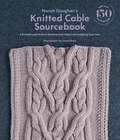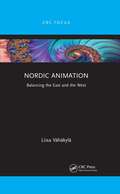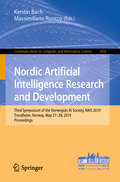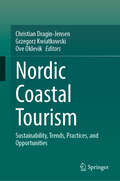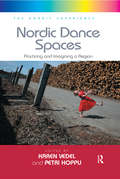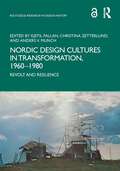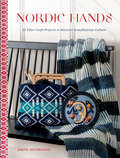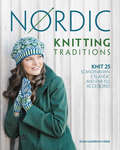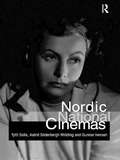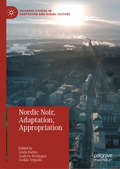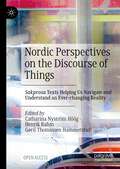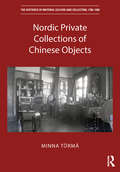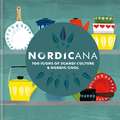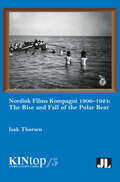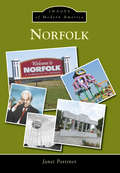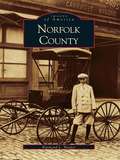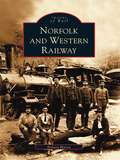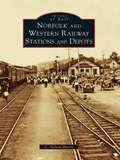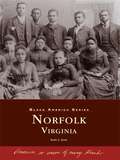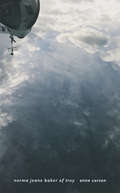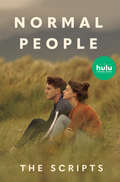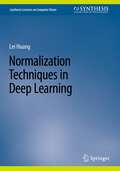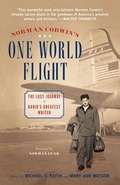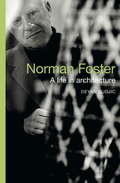- Table View
- List View
Norah Gaughan's Knitted Cable Sourcebook: A Breakthrough Guide to Knitting with Cables and Designing Your Own
by Norah GaughanA groundbreaking stitch dictionary from a cable master, featuring 150 cable stitch patterns and fifteen garment patterns to test your skills.This guide for the modern knitter presents more than 150 new and innovative cable stitch patterns ranging from basic to complex and offers enlightening insight into how cables are engineered, how knitters can design their own, and how knitters can mix and match cables in a knitting pattern. Teacher, author, and master knitter Norah Gaughan shares her design principles and offers clear cable-making instruction throughout, always in a conversational, easy-to-understand voice that proceeds naturally, as one cable idea leads to the next. Master the art of cable knitting, then test your newfound skills with the fifteen garment patterns for wraps, sweaters, and accessories.
Nordic Animation: Balancing the East and the West (Focus Animation Ser.)
by Liisa VähäkyläThis book examines the state of the animation industry within the Nordic countries. It looks at the success of popular brands such as Moomins and The Angry Birds, studios such as Anima Vitae and Qvisten, and individuals from the Nordics who have made their mark on the global animation industry. This book begins with some historical findings, before moving to recount stories of some of the most well-known Nordic animation brands. A section on Nordic animation studios examines the international success of these companies and its impact on the global animation industry. This book is forward-thinking in scope and places these stories within the context of what the future holds for the Nordic animation industry. This book will be of great interest to those in the fields of animation and film studies, as well as those with a general interest in Nordic animation.
Nordic Artificial Intelligence Research and Development: Third Symposium of the Norwegian AI Society, NAIS 2019, Trondheim, Norway, May 27–28, 2019, Proceedings (Communications in Computer and Information Science #1056)
by Kerstin Bach Massimiliano RuoccoThis book constitutes the refereed proceedings of the Third Symposium of the Norwegian AI Society, NAIS 2019, held in Trondheim, Norway, in May, 2019. The 11 full papers and 3 short papers were carefully reviewed and selected from 21 submissions. The papers focus on all aspects of: artificial intelligence; machine learning; knowledge representation; robotics; planning and scheduling; natural language processing; computer vision; search algorithms; multi-agent-systems; industrial applications; and philosophical and ethical foundations.
Nordic Coastal Tourism: Sustainability, Trends, Practices, and Opportunities
by Grzegorz Kwiatkowski Christian Dragin-Jensen Ove OklevikThis book explores sustainable tourism development and examines the development strategies of different coastal regions in the Nordic region. In recent decades, tourism research has been topical among researchers in the Nordic region and in international tourism literature. Especially important in this is research on coastal tourism, which is both a linear and area-based activity. An increased interest in coastal tourism has been determined by the fact that around 40 percent of the world’s population lives on the coast or within the coastal zone, and these communities are dependent on coastal tourism besides their other professions, such as fisheries, agriculture, and commercial port activities. Nordic coasts combine a rich maritime heritage and tradition with an unrivalled diversity of landscapes and natural refuges. Its oceans and seas are known for their biological richness and great beauty. Coastal and maritime tourism constitutes one of the Nordic countries' most important touristic thematic sub-sectors. With further perspectives for growth in the coming years, coastal and maritime tourism’s full potential is yet to be unveiled. Guaranteeing the conditions for sustainable coastal and maritime tourism development may significantly contribute to Nordic's economic growth and employment. It can also support the sustainable development of the more remote coastal regions, bringing the Nordics closer together and endowing coastal communities with sustainable solutions for the future.
Nordic Dance Spaces: Practicing and Imagining a Region (The Nordic Experience #4)
by Petri HoppuDance has been connected to the practices and ideologies that have shaped notions of a Nordic region for more than a century and it is ingrained into the culture and society of the region. This book investigates different dance phenomena that have either engaged with or dismantled notions of Nordicness. Looking to the motion of dancers and dance forms between different locations, organizations and networks of individuals, its authors discuss social dancing, as well as historical processes associated with collaborations in folk dance and theatre dance. They consider how similarities and differences between the Nordic countries may be discerned, for instance in patterns of reception at the arrival of dance forms from outside the Nordic countries - and vice versa, how dance from the Nordic countries is received in other parts of the world, as seen for example in the Nordic Cool Festival at the Kennedy Centre in 2013. The book opens a rare window into Nordic culture seen through the prism of dance. While it grants the reader new insights into the critical role of dance in the formation and imagining of a region, it also raises questions about the interplay between dance practices and politics.
Nordic Design Cultures in Transformation, 1960–1980: Revolt and Resilience (Routledge Research in Design History)
by Kjetil Fallan Anders V. Munch Christina ZetterlundCovering the 1960s and 1970s, this volume explores new ways of investigating, comparing and interpreting the different domains of design culture across the Nordic countries. Challenging the traditional narrative, this volume argues that the roots of the most prominent features of Nordic design’s contemporary significance are not to be found amongst the objects for the home collectively branded as ‘Scandinavian Design’ to great acclaim in the 1950s, but in the discourses, institutions and practices formed in the aftermath of that oft-told success story, during the turbulent period between 1960 and 1980. This is achieved by employing multidisciplinary approaches to connect the domains of industrial production, marketing, consumption, public institutions, design educations, trade journals as well as public debates and civic initiatives forming a design culture. This book makes a significant contribution to current, international agendas of historiographical critique focusing on transnational relations and the deconstruction of national design histories. This book will be of interest to scholars in design, design history and Scandinavian studies.
Nordic Hands: 25 Fiber Craft Projects to Discover Scandinavian Culture
by Anita OsterhaugUnderstand the culture and traditions behind the charm, to enjoy meaningful makingMeets the needs of two content-hungry audiences: fiber artists and Nordic craft enthusiastsAdopt some of Nordic life's cultural norms, like gökotta (to have a picnic at dawn to hear the first bird&’s song)
Nordic Knitting Traditions: Knit 25 Scandinavian, Icelandic and Fair Isle Accessories
by Susan Anderson-FreedKnit Gorgeous Colorwork Accessories in the Nordic Tradition! Traditional Scandinavian and Icelandic designs are given new life in the projects found in Nordic Knitting Traditions. 25 projects feature original floral, star, feather and geometric motifs, all knit in fresh and modern colors. With a diverse collection of hats, tams, mittens, gloves, socks, knee-highs and legwarmers, you'll find plenty of jaw-dropping, colorful accessories to knit for yourself and the ones you love. Inside: Thoughtful construction and full-color charts make these designs easy to knit. Variations for knitting mittens and gloves in two ways and lengthening socks into knee-highs, as well as fully charted alternative colorways, allow you to achieve customized looks. "Complete the Look" instructions guide you to patterns that match, making it easy to create coordinating accessories. Tips and tricks for sizing, construction and stress-free knitting help you knit items that will become family heirlooms. Nordic Knitting Traditions celebrates the roots of stranded knitting with inspiring designs and elegant colorways. Start knitting your own piece of history today.
Nordic National Cinemas
by Gunnar Iverson Astrid Soderbergh Widding Tytti SoilaNordic National Cinemas explores the film histories and cultures of Denmark, Finland, Iceland, Norway and Sweden. The authors examine each country's domestic film production, social and political context and domestic audiences from the beginning of this century to the twentieth century.The authors not only explore the work of internationally renowned figures such as Mauritz Stiller, Victor Sjostrom, Carl Dreyer and Ingmar Bergman, directors of such classics as Vampyr, Ordet, Wild Strawberries and Cries and Whispers, but also nationally important film makers such as August Blom, Bodil Ipsen, Lau Lauritzen and Nils Malmros, they also discuss contemporary film makers including Gabriel Axel, director of Babette's Feast, the Kaurismaki brothers, directors of The Match Factory Girl and The Leningrad Cowboys and the recently acclaimed Lars von Trier, director of Breaking the Waves.
Nordic Noir, Adaptation, Appropriation (Palgrave Studies in Adaptation and Visual Culture)
by Andrew Nestingen Linda Badley Jaakko SeppäläThis book argues that adaptation is an underrecognized yet constitutive element of Nordic noir. In so doing, it reframes the prevailing critical view. Now celebrated for its global sweep, Nordic noir is equally a transmedial phenomenon. Nordic Noir, Adaptation, Appropriation deploys the tools of current adaptation studies to undertake a wide-ranging transcultural, intermedial exploration, adding an important new layer to the rich scholarship that has arisen around Nordic noir in recent years.
Nordic Perspectives on the Discourse of Things: Sakprosa Texts Helping Us Navigate and Understand an Ever-changing Reality
by Catharina Nyström Höög Henrik Rahm Gøril Thomassen HammerstadThis open access book deals with the role of written texts in an increasingly diverse and dynamic society, bringing together a series of studies anchored in the Scandinavian research tradition of sakprosa, which roughly translates as ‘subject-oriented prose’ or ‘professional communication’. The authors examine the written text’s capacity to transcend contextual boundaries, as a crucial factor in the importance of capturing and maintaining content as a manageable entity. The chapters each deal with a text type that manages complex content in a specialized way, including genre shifting in CSR reports, discourse networks in modern digital culture, digital and social media crisis communication, and epistemic positions in non-fiction. This book is relevant to fields such as text research, professional/digital communication, discourse analysis and literacy studies, and may also be of interest to disciplines such as history, rhetoric, organization studies, media studies/journalism, and linguistics.
Nordic Private Collections of Chinese Objects (The Histories of Material Culture and Collecting, 1700-1950)
by Minna TörmäThis book explores the ways in which Nordic private collectors displayed their collections of Chinese objects in their homes. This leads to a reconsideration of how to define collecting and display by analysing the difference between objects serving as decorative or collectible items, while tracing collecting and display trends of the twentieth century. Minna Törmä examines four Scandinavian collections as case studies: Kustaa Hiekka, Sophus Black, Osvald Sirén and Marie-Louise and Gunnar Didrichsen, all of whom had professional backgrounds (a jeweler, two businessmen and a scholar) and for whom collecting became a passion and an educational endeavour. This book will be of interest to scholars in art history, museum studies, Chinese studies and design history.
Nordicana: 100 Icons of Scandi Culture & Nordic Cool
by Kajsa Kinsella Arrow Film Distributors LtdYou've watched every Scandi TV series going, you have Nordic light fittings, and you want Birgitte Nyborg as your Prime Minister. Yes it's fair to say there is a general love-in with everything related to the northern countries.Over the last decade, the Nordic nations have quietly and unassumingly come to hold us in their thrall; but what is it, exactly, that we covet about their culture?Nordicana celebrates the objects, aesthetics and traditions that have inspired our obsession, with a quick introduction to 100 icons of Scandi style and Nordic cool, accompanied by beautiful illustrations.
Nordisk Films Kompagni 1906-1924, Volume 5: The Rise and Fall of the Polar Bear
by Isak ThorsenNordisk Films Kompagni 1906–1924: The Rise and Fall of the Polar Bear is the first comprehensive study of the Danish film company, Nordisk Films Kompagni, in the silent era. Based on archival research, primarily in the company’s surviving business archives, this volume of KINtop describes and analyzes how Nordisk Film became one of the leading players in the world market and why the company failed to maintain this position. This volume is written from perspective of Nordisk Film as a business and organization, from its establishment in 1906 until 1924 when founder Ole Olsen stepped back. Among the many topics and themes this volume examines are the competitive advantages Nordisk Film gained in reorganizing the production to multiple-reel films around 1910; the company’s highly efficient film production which anticipated the departmentalized organization of Hollywood; Nordisk Film’s aggressive expansion strategy in Germany, Central-Europe and Russia during the First World War; and the grand plans for taking control of UFA in association with the American Famous Players in the post-war years.
Norfolk (Images of Modern America)
by Janet PortinerIn July 1866, three wagon trains of German immigrants from Wisconsin arrived at their new home on the North Fork of the Elkhorn River in northeastern Nebraska. The settlers intended to call the town Northfork, but in 1868, when the abbreviated "Norfork" was submitted to federal postal authorities, the government assumed the name was misspelled and changed it to Norfolk. Since the town's founding, the story of the community has been one of continuous growth that has led to a bountiful, thriving town. Norfolk's hardworking people are generous, welcoming, and open to new ideas. Though it has changed with time, the unconquerable spirit of the city remains young and active. Images of Modern America: Norfolk is a photographic journey into the 21st century.
Norfolk County (Images of America)
by Raymond L. HarperA major player in the country's development, Norfolk County possesses a unique history, one that reflects the many challenges and accomplishments that America has experienced since the country's birth in the late eighteenth century. The county's citizens have weathered a variety of storms, both natural and manmade, ranging from hurricanes, floods, British occupation and attacks, Federal occupation, and aggressive civic annexation, and have created a beautiful and useful landscape, appealing to both the artist's eye and industrialist's practicality.This volume, with over 200 black-and-white images, takes readers into one of the Tidewater region's most historic locations and into an age made memorable by its unpaved roads, its early streetcars and horse-drawn wagons, its lively waterfront district on the Elizabeth River, and its emerging cityscape bordered by picturesque dairy farms. A rare visual journey, Norfolk County explores, through word and image, the area's diverse past, touching upon many elements of everyday life, including scenes of early one-room schoolhouses, historic churches, well-known industries, lush countrysides, and life along the river, as well as capturing vintage views of Great Bridge, Deep Creek,and the Great Dismal Swamp.
Norfolk and Western Railway (Images of Rail)
by Nelson HarrisFor a century, the Norfolk and Western Railway operated as one of the greatest transportation companies in the southeastern United States. From developing the coal fields of West Virginia to accommodating passengers aboard its famous Powhaten Arrow and Pocahontas lines, the N&W was the last major railroad to abandon the steam engine. The story of the N&W is a story about people-a story of the tens of thousands of people who worked in the shops and aboard the trains, sold the tickets and moved the freight, laid the track and managed corporate affairs. Images of Rail: Norfolk and Western Railway celebrates that heritage through the lens of some 200 archival photographs.From images of the muscular Class J steam locomotive to the lone agent of the rural depot, these photographs have been harvested from the N&W's files at the Virginia Museum of Transportation. The archival material provides the reader the rare opportunity to rummage through the N&W's attic. See the engine crews at the turn of the last century, the shop gangs, freight agents, roundhouses, stations, and iron horses of a bygone age. With views of the rugged and, at times, dangerous days of railroading in the late 1800s to the rise of the N&W as a member of America's corporate elite, these pictures convey the railway's storied history.
Norfolk and Western Railway Stations and Depots
by C. Nelson HarrisThe tracks of the Norfolk and Western Railway snaked through Virginia's Shenandoah Valley and the coalfields of West Virginia. For nearly 100 years, the Norfolk and Western brought freight, passengers, and economic vitality to large cities and rural mining towns. At each stop was the depot or station; some stations were large, architecturally ornate structures that represented the muscular energy and romantic era of this great steam railway with its famed J-class engines. In other places there were small wooden depots that depicted the hard-scrabble life of the mining communities, tucked amid steep mountain valleys that were indelibly shaped by the railway's presence. Today some of those structures remain, while many disappeared when the railway ceased passenger or other service. The Norfolk and Western eventually merged with the Southern Railway, and though the trains of the Norfolk Southern still run along those same lines, they simply pass by where they used to stop many years ago.
Norfolk, Virginia (Black America Series)
by Ruth A. RoseNorfolk has been a center of African-American life since this country's humble beginnings, when indentured African servants arrived in 1619 to the Tidewater region. Since that time, the African-American population has endured the atrocities of slavery, poverty, and inequality, and has emerged, through a remarkable combination of hard work, perseverance, and faith, as a vibrant community and an integral component to the identity and success of Norfolk and surrounding areas.
Norma Jeane Baker of Troy (Oberon Modern Plays Ser.)
by Anne CarsonAnne Carson’s new work that reconsiders the stories of two iconic women—Marilyn Monroe and Helen of Troy—from their point of view Norma Jeane Baker of Troy is a meditation on the destabilizing and destructive power of beauty, drawing together Helen of Troy and Marilyn Monroe, twin avatars of female fascination separated by millennia but united in mythopoeic force. Norma Jeane Baker was staged in the spring of 2019 at The Shed’s Griffin Theater in New York, starring actor Ben Whishaw and soprano Renée Fleming and directed by Katie Mitchell.
Normal People: The Scripts
by Sally RooneyDelve deeper into the Emmy- and Golden Globe–nominated Hulu series based on Sally Rooney's bestselling novel with this must-have collection of the Normal People scripts, featuring behind-the-scenes photos and an introduction by director Lenny Abrahamson.&“You know, I did used to think that I could read your mind at times.&”&“In bed you mean.&”&“Yeah. And afterwards but I dunno maybe that's normal.&”&“It&’s not.&”Connell and Marianne grow up in the same small town in the west of Ireland, but the similarities end there. In school, Connell is popular. Marianne is a loner. But when the two strike up a conversation, something life-changing begins.With an introduction by director Lenny Abrahamson and featuring iconic images from the show, Normal People: The Scripts contains the complete screenplays of the acclaimed Emmy- and Golden Globe–nominated television drama that The New York Times called &“an unusually thoughtful and moving depiction of young people&’s emotional lives.&”
Normalization Techniques in Deep Learning (Synthesis Lectures on Computer Vision)
by Lei HuangThis book presents and surveys normalization techniques with a deep analysis in training deep neural networks. In addition, the author provides technical details in designing new normalization methods and network architectures tailored to specific tasks. Normalization methods can improve the training stability, optimization efficiency, and generalization ability of deep neural networks (DNNs) and have become basic components in most state-of-the-art DNN architectures. The author provides guidelines for elaborating, understanding, and applying normalization methods. This book is ideal for readers working on the development of novel deep learning algorithms and/or their applications to solve practical problems in computer vision and machine learning tasks. The book also serves as a resource researchers, engineers, and students who are new to the field and need to understand and train DNNs.
Norman Corwin's One World Flight: The Lost Journal of Radio's Greatest Writer
by Norman Corwin Michael C. Keith Mary Ann WatsonA towering figure in broadcast history, Norman Corwin has long been known as "Radio's Poet Laureate." In the late 1930s, a creative revolution was underway in the medium. What some people still called "the wireless" was maturing from a novelty into an art form. After a ten-year career as a newspaperman, columnist, and critic--which began at the age of 17--Corwin joined the ranks of aural provocateurs such as Archibald MacLeish, Arch Oboler, and Orson Welles.
Norman Foster: A Life in Architecture
by Deyan SudjicA biography of Lord Foster, one of the world's foremost architects, written with his full co-operation.Norman Foster is a phenomenon - as an architect, but also as an individual. He is responsible for a dozen or more of the most recognisable buildings of the last thirty years. Under his driven leadership, what is now called Foster and Partners has grown to an international firm with almost 1,000 employees, building astonishing constructions all over the world. Deyan Sudjic explores the nature of the impact that he has had on architecture, and on the contemporary city. It traces his remarkable journey from the backstreets of Manchester, the determination with which he has built a global architectural practice, and his huge creative impact on what we see around us.Amongst many other buildings, Norman Foster is responsible for the design of Beijing's new airport, one of the world's largest, for the Rossiya tower in Moscow, in contention to be the tallest skyscraper in Europe until the credit crunch killed it, for one of the towers at Ground Zero in Manhattan, and for a crop of new towers in London. He designed the Reichstag, the Hong Kong and Shanghai Banks headquarters in London and China, the new Wembley stadium and the British Museum's new court.Deyan Sudjic's insightful and elegantly written biography charts the remarkable life of one of the world's most influential architectural figures.
Norman Foster: A Life in Architecture
by Deyan SudjicA biography of Lord Foster, one of the world's foremost architects, written with his full co-operation.Norman Foster is a phenomenon - as an architect, but also as an individual. He is responsible for a dozen or more of the most recognisable buildings of the last thirty years. Under his driven leadership, what is now called Foster and Partners has grown to an international firm with almost 1,000 employees, building astonishing constructions all over the world. Deyan Sudjic explores the nature of the impact that he has had on architecture, and on the contemporary city. It traces his remarkable journey from the backstreets of Manchester, the determination with which he has built a global architectural practice, and his huge creative impact on what we see around us.Amongst many other buildings, Norman Foster is responsible for the design of Beijing's new airport, one of the world's largest, for the Rossiya tower in Moscow, in contention to be the tallest skyscraper in Europe until the credit crunch killed it, for one of the towers at Ground Zero in Manhattan, and for a crop of new towers in London. He designed the Reichstag, the Hong Kong and Shanghai Banks headquarters in London and China, the new Wembley stadium and the British Museum's new court.Deyan Sudjic's insightful and elegantly written biography charts the remarkable life of one of the world's most influential architectural figures.
